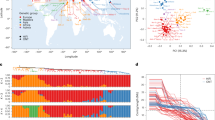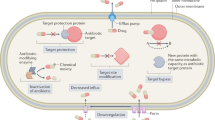Abstract
Widespread use of antimalarial agents can profoundly influence the evolution of the human malaria parasite Plasmodium falciparum. Recent selective sweeps for drug-resistant genotypes may have restricted the genetic diversity of this parasite, resembling effects attributed in current debates1,2,3,4 to a historic population bottleneck. Chloroquine-resistant (CQR) parasites were initially reported about 45 years ago from two foci in southeast Asia and South America5, but the number of CQR founder mutations and the impact of chlorquine on parasite genomes worldwide have been difficult to evaluate. Using 342 highly polymorphic microsatellite markers from a genetic map6, here we show that the level of genetic diversity varies substantially among different regions of the parasite genome, revealing extensive linkage disequilibrium surrounding the key CQR gene pfcrt7 and at least four CQR founder events. This disequilibrium and its decay rate in the pfcrt-flanking region are consistent with strong directional selective sweeps occurring over only ∼20–80 sexual generations, especially a single resistant pfcrt haplotype spreading to very high frequencies throughout most of Asia and Africa. The presence of linkage disequilibrium provides a basis for mapping genes under drug selection in P. falciparum.
This is a preview of subscription content, access via your institution
Access options
Subscribe to this journal
Receive 51 print issues and online access
$199.00 per year
only $3.90 per issue
Buy this article
- Purchase on Springer Link
- Instant access to full article PDF
Prices may be subject to local taxes which are calculated during checkout



Similar content being viewed by others
References
Rich, S. M. & Ayala, F. J. The recent origin of allelic variation in antigenic determinants of Plasmodium falciparum. Genetics 150, 515–517 (1998)
Volkman, S. K. et al. Recent origin of Plasmodium falciparum from a single progenitor. Science 293, 482–484 (2001)
Hughes, A. L. & Verra, F. Very large long-term effective population size in the virulent human malaria parasite Plasmodium falciparum. Proc. R. Soc. Lond. B 268, 1855–1860 (2001)
Hey, J. Parasite populations: the puzzle of Plasmodium. Curr. Biol. 9, R565–R567 (1999)
Payne, D. Spread of chloroquine resistance in Plasmodium falciparum. Parasitol. Today 3, 241–246 (1987)
Su, X. et al. A genetic map and recombination parameters of the human malaria parasite Plasmodium falciparum. Science 286, 1351–1353 (1999)
Fidock, D. A. et al. Mutations in the P. falciparum digestive vacuole transmembrane protein PfCRT and evidence for their role in chloroquine resistance. Mol. Cell 6, 861–871 (2000)
Anderson, T. J. et al. Microsatellite markers reveal a spectrum of population structures in the malaria parasite Plasmodium falciparum. Mol. Biol. Evol. 17, 1467–1482 (2000)
Escalante, A. A., Barrio, E. & Ayala, F. J. Evolutionary origin of human and primate malarias: evidence from the circumsporozoite protein gene. Mol. Biol. Evol. 12, 616–626 (1995)
Conway, D. J. et al. Origin of Plasmodium falciparum malaria is traced by mitochondrial DNA. Mol. Biochem. Parasitol. 111, 163–171 (2000)
Djimde, A. et al. A molecular marker for chloroquine-resistant falciparum malaria. N. Engl. J. Med. 344, 257–263 (2001)
Dorsey, G., Kamya, M. R., Singh, A. & Rosenthal, P. J. Polymorphisms in the Plasmodium falciparum pfcrt and pfmdr-1 genes and clinical response to chloroquine in Kampala, Uganda. J. Infect. Dis. 183, 1417–1420 (2001)
Conway, D. J. et al. High recombination rate in natural populations of Plasmodium falciparum. Proc. Natl Acad. Sci. USA 96, 4506–4511 (1999)
Hill, W. G., Babiker, H. A., Ranford-Cartwright, L. C. & Walliker, D. Estimation of inbreeding coefficients from genotypic data on multiple alleles, and application to estimation of clonality in malaria parasites. Genet. Res. 65, 53–61 (1995)
Walliker, D., Babiker, H. & Ranford Cartwright, L. in Malaria: Parasite Biology, Pathogenesis, and Protection (ed. Sherman, I. W.) 235–252 (American Society for Microbiology, Washington DC, 1998)
Paul, R. E. et al. Mating patterns in malaria parasite populations of Papua New Guinea. Science 269, 1709–1711 (1995)
Trager, W. & Jensen, J. B. Human malaria parasites in continuous culture. Science 193, 673–675 (1976)
Su, X., Kirkman, L. A., Fujioka, H. & Wellems, T. E. Complex polymorphisms in an approximately 330 kDa protein are linked to chloroquine-resistant P. falciparum in Southeast Asia and Africa. Cell 91, 593–603 (1997)
Dye, C. & Williams, B. G. Multigenic drug resistance among inbred malaria parasites. Proc. R. Soc. Lond. B 264, 61–67 (1997)
Nomura, T. et al. Evidence for different mechanisms of chloroquine resistance in 2 Plasmodium species that cause human malaria. J. Infect. Dis. 183, 1653–1561 (2001)
Acknowledgements
We thank various investigators who provided the isolates over the years, S. Davis-Hayman, D. Joy, K. Hayton and B. Marshall for critical reading of the manuscript and editorial assistance, and T. Wellems, L. Miller and D. Lipman for support and encouragement. The opinions of the authors do not necessarily reflect those of the US army or the Department of Defense.
Author information
Authors and Affiliations
Corresponding author
Ethics declarations
Competing interests
The authors declare that they have no competing financial interests.
Rights and permissions
About this article
Cite this article
Wootton, J., Feng, X., Ferdig, M. et al. Genetic diversity and chloroquine selective sweeps in Plasmodium falciparum. Nature 418, 320–323 (2002). https://doi.org/10.1038/nature00813
Received:
Accepted:
Issue Date:
DOI: https://doi.org/10.1038/nature00813
This article is cited by
-
Two transporters enable chloroquine resistance in malaria
Nature Microbiology (2023)
-
Efficacy of three anti-malarial regimens for uncomplicated Plasmodium falciparum malaria in Cambodia, 2009–2011: a randomized controlled trial and brief review
Malaria Journal (2022)
-
Malaria chemoprevention and drug resistance: a review of the literature and policy implications
Malaria Journal (2022)
-
Historical trends and new surveillance of Plasmodium falciparum drug resistance markers in Angola
Malaria Journal (2021)
-
Kelch 13-propeller polymorphisms in Plasmodium falciparum from Jazan region, southwest Saudi Arabia
Malaria Journal (2020)
Comments
By submitting a comment you agree to abide by our Terms and Community Guidelines. If you find something abusive or that does not comply with our terms or guidelines please flag it as inappropriate.



